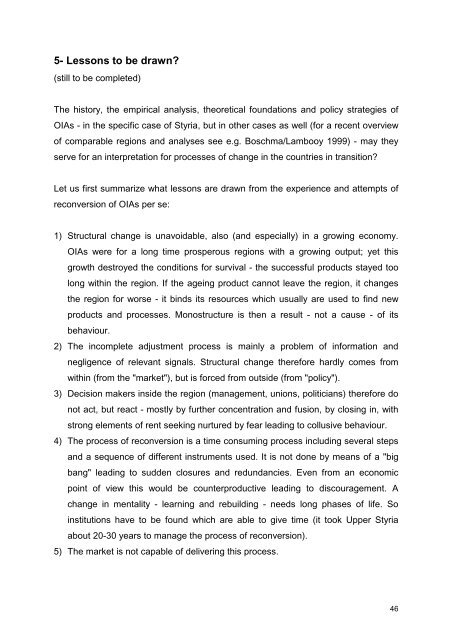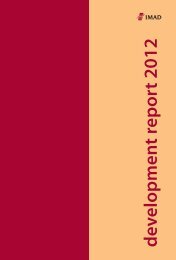Institutional Change in Old Industrial Areas – Lessons for ... - UMAR
Institutional Change in Old Industrial Areas – Lessons for ... - UMAR
Institutional Change in Old Industrial Areas – Lessons for ... - UMAR
You also want an ePaper? Increase the reach of your titles
YUMPU automatically turns print PDFs into web optimized ePapers that Google loves.
5- <strong>Lessons</strong> to be drawn?<br />
(still to be completed)<br />
The history, the empirical analysis, theoretical foundations and policy strategies of<br />
OIAs - <strong>in</strong> the specific case of Styria, but <strong>in</strong> other cases as well (<strong>for</strong> a recent overview<br />
of comparable regions and analyses see e.g. Boschma/Lambooy 1999) - may they<br />
serve <strong>for</strong> an <strong>in</strong>terpretation <strong>for</strong> processes of change <strong>in</strong> the countries <strong>in</strong> transition?<br />
Let us first summarize what lessons are drawn from the experience and attempts of<br />
reconversion of OIAs per se:<br />
1) Structural change is unavoidable, also (and especially) <strong>in</strong> a grow<strong>in</strong>g economy.<br />
OIAs were <strong>for</strong> a long time prosperous regions with a grow<strong>in</strong>g output; yet this<br />
growth destroyed the conditions <strong>for</strong> survival - the successful products stayed too<br />
long with<strong>in</strong> the region. If the age<strong>in</strong>g product cannot leave the region, it changes<br />
the region <strong>for</strong> worse - it b<strong>in</strong>ds its resources which usually are used to f<strong>in</strong>d new<br />
products and processes. Monostructure is then a result - not a cause - of its<br />
behaviour.<br />
2) The <strong>in</strong>complete adjustment process is ma<strong>in</strong>ly a problem of <strong>in</strong><strong>for</strong>mation and<br />
negligence of relevant signals. Structural change there<strong>for</strong>e hardly comes from<br />
with<strong>in</strong> (from the "market"), but is <strong>for</strong>ced from outside (from "policy").<br />
3) Decision makers <strong>in</strong>side the region (management, unions, politicians) there<strong>for</strong>e do<br />
not act, but react - mostly by further concentration and fusion, by clos<strong>in</strong>g <strong>in</strong>, with<br />
strong elements of rent seek<strong>in</strong>g nurtured by fear lead<strong>in</strong>g to collusive behaviour.<br />
4) The process of reconversion is a time consum<strong>in</strong>g process <strong>in</strong>clud<strong>in</strong>g several steps<br />
and a sequence of different <strong>in</strong>struments used. It is not done by means of a "big<br />
bang" lead<strong>in</strong>g to sudden closures and redundancies. Even from an economic<br />
po<strong>in</strong>t of view this would be counterproductive lead<strong>in</strong>g to discouragement. A<br />
change <strong>in</strong> mentality - learn<strong>in</strong>g and rebuild<strong>in</strong>g - needs long phases of life. So<br />
<strong>in</strong>stitutions have to be found which are able to give time (it took Upper Styria<br />
about 20-30 years to manage the process of reconversion).<br />
5) The market is not capable of deliver<strong>in</strong>g this process.<br />
46
















